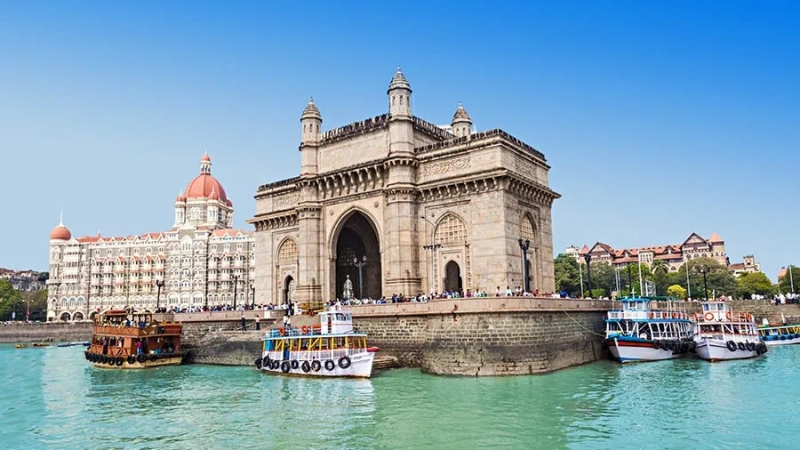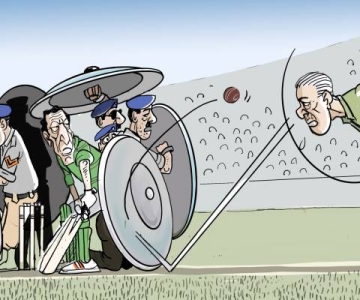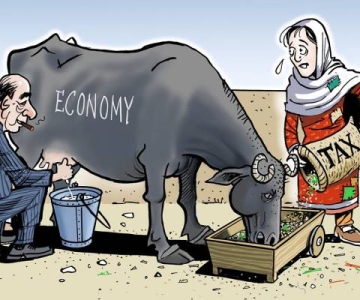Part I of the series can be accessed here
In Part II of this series, I traveled to India’s thriving megapolis with a media delegation
After a whirlwind Delhi tour, the Pakistani media persons set off for a fleeting visit to Mumbai. If I am not mistaken, ours was the first big delegation to this megapolis that crossed the contemporary fault line between India and Pakistan. Less than a dozen zealot-mercenaries terrorized Mumbai twenty months ago, and now the issue of terrorism has derailed the formal Indo-Pakistan talks.
This was not a very comfortable journey. Not that we were not looked after by our hosts. It was a well-organized tour. But the overdose of Mumbai mantra in Delhi had rattled some of us. What happened there in November 2008 was ghastly and inhuman; and Ajmal Kasab’s nationality stirred public opinion like never before. Thanks to a belligerent media and live telecast of terrorism (almost to the point of glorifying it) the result was what the jihadis had hoped for. Jingoism flourishes in such odd climes and the Mumbai hangover, as we all found, is a potent reality in India.
Within the delegation, I underwent a strange sensation – of a remote, awkward connectedness with the place. Twenty years ago, as an apolitical and naive student I had arrived in Bombay to see my friends from the London School of Economics. This was a ten day long trip, which I shall not forget for many reasons. I found a cosmopolitan buzz, abject poverty and immense human bonding then. I stayed in a building where Bollywood’s long-lasting diva Helen lived, and met scores of young men and women who looked the same but adhered to a different lifestyle.
Thanks to this wheel of journo-fortune, I found myself at the airport exactly two decades later, with a packed itinerary. Bombay monsoons, despite the havoc they cause, are quite enchanting. The polluted environ rejuvenates and bored trees start singing. Such are the delights of a tropical ecological zone.
Things had changed. Bombay has metamorphosed into Mumbai (shining India is also more parochial); Sahar airport had been renamed (as Chatrapathi Shivaji International Airport) after the great Maratha leader Shivaji, who happens to be a villain in our textbooks for having defied the Mughals. The mythology around Shivaji is fascinating. On our last day, the tour guide, an amiable and educated woman, told us how he escaped the Mughal prisons and covered a thousand miles on horseback to reach Maharashtra. The airport looked swankier and many slums that shocked me in 1990 had been upgraded. If anything Mumbai looks far cleaner and more efficient than before.
We stayed at the Trident (Nariman Point) hotel, which was also attacked in November 2008. The premises had been renovated and the place has been reinterpreted in postmodern styles and hues. The hotel is located next to the sea and the civilized pavements enable you to stroll along the long beach. Less than a kilometre away is the Nana-Nani Park specially designed for older people, where they can hang out and get some exercise. Only in Bombay!
Monsoon rain slowed our journey to the hotel. From the Shivaji airport to our hotel, it took us two hours. Already late for our appointment at the Export-Import (EXIM) Bank of India, we had to huddle yet again into the minibus to meet our hosts. A sumptuous lunch awaited us in an old building where the bank offices are located. EXIM, though a public sector institution, was quite an impressive outfit. We were briefed on India’s growing economy and vibrant banking sector. This is where we learnt that now 70% of the Indian economy was documented due to a rational tax regime introduced as part of the recent economic reforms. India’s trade is expanding with China, and the current volume stands at 60 billion dollars per annum. When we discussed the scope and viability of India-Pakistan trade this was a helpful figure. Irrespective of their old hostilities China and India are trading with each other. Pakistan’s self serving experts often scare us about India flooding our market and capturing our economy at the cost of consumers. Almost all consumables are cheaper in India. Of course the ‘ideology’ – an imagined construct – stops us. We are happy to beg from ‘infidels’ but averse to trade with our neighbours.
Having said this it was illuminating to note that formal trade between the two enemies had crossed the two billion dollar mark in 2008. There are strong economic lobbies on both sides that are waiting for a grand thaw to jump in. But the politicians, bureaucrats and kleptocrats prevent this from happening on both sides.
The Pakistani delegation asked several questions and the responses from the EXIM professionals were objective and devoid of the political overtones that we heard in Delhi. Thankfully, the Mumbai attacks were not mentioned even once. It does get a little over-the-top when you are furthering peace and have to engage in jingoistic discourse.
Coming back to the hotels and the psychological aftermath of 26/11, the security at the Bombay hotels was quite intense. Vehicles and body searches were part of the routine. After we returned from our official meeting, we also walked towards the ill-fated Taj hotel that perhaps is the single most important visual representation of the 2008 attacks. On the opposite side, the majestic Gateway of India peacefully watched the multitude of tourists and the pigeons. It was quite an eerie experience as we stood there just before dusk was to change the colour of the sky.
I had forgotten what the city looked like. It is electric in its speed and visually a planet out of the early colonial India. The Portuguese and the English architectural sensibilities mark Bombay’s landscape. The influences are eclectic – from the Roman, Gothic to the hybridized version of Anglo-Indian. A drive around the city was fascinating as we passed the venues known for their Bombay stamp – Churchgate, Victoria (now Chhatrapati Shivaji ) Terminus, numerous churches and cathedrals. Cyril Almedia was lucky as he tagged along the city with his friend Zasha Colah who works as a curator at the Prince of Wales Museum. He reported the next morning about his relentless pursuit of a city reminding me of a Bollywood flick, Iss raat ki subah nahee – a film where a Bombay underground drama and high-pitched action unfold all in one night. Good (and not so) old Cyril proved to be the new avatar of the film hero who had managed so many sights and sounds in one night.
Anjum Rehman went off to see her friends and relatives including Chauhdry Khaliquzzaman’s family, where she was accosted with many complaints on what ‘Pakistanis’ had done to the city. Kamran Shahid was planning stories and interviews like an ambitious TV journalist, and quite sensibly stayed away from the Hafiz Saeed debate but defended Pakistan’s interests vehemently, when required. A Sardarji who was his classmate at the London University picked up Asim Awan from the hotel. Indians and Pakistanis forge great friendships once outside contested territories and imaginations.
I met my friend Naheed Carrimjee, a thorough Bombayite with the right accent and credentials that boast of a native girl. Meeting her after those tumultuous college years was truly thrilling, as we caught up on our lives, friends and all the vicissitudes. I was saddened to learn that her lovely parents who looked after me were no more. Naheed is now a leading lawyer of the city, fully immersed in a thriving practice and rights’ activism in the Bombay slums.
Naheed woefully related how she lost many friends and acquaintances in the Mumbai attacks. But she refrained from name-calling and pointing fingers. She is too civilized. We walked around in Colaba, shopped at the chic Bombay Store and then chatted in an old cafe that was adequately quaint for my liking. Dressed in a cotton sari with a pearl necklace, this was a different version of the person I knew: Getting-old-syndrome. The last time we hung out, life was free of professions, obligations and ambitions. Naheed’s sister ended up marrying a Pakistani corporate wizard in Boston. Despite the iron curtain and enemy construction, human bonds are difficult to control, even by nuclear-armed states.
Before flying out I managed to drag out quite a few colleagues to visit the Haji Ali dargah, located in the sea. This was another deja vu moment, as the shrine has not changed much. The poor tour guide of ours did not know much except that it was another proof of India’s secularism. We had of course heard this one before, well, endlessly. On our way back, a quick city tour was effected: The landmarks, parks and a drive on the Malabar Hill. This is also the area where Jinnah’s contested, forlorn house stands much like his shattered dream of Hindu-Muslim Unity. But this is also where the ugly reality of today’s India stares you in your face through the one billion dollar home being built by Mukesh Ambani – India’s best-known billionaire who gifted a jet to his wife on her birthday.
Yet Bombay’s entrepreneurial commoners are up to interesting stuff. Thousands of dabbawalas supply lunch tiffins to 250,000 people in their offices – they pick up and drop the tiffin each day with precision and remarkable efficiency. Smart washermen communities handle hundreds of thousands of laundry items and deliver them at your home. But the most interesting snippet for me was how the old British era factories, now abandoned due to changed economic circumstances, were being recycled to preserve heritage and reinvent their spatial use.
I found this out when I was taken to a dinner party by another set of college friends: Naina and Vivek. An old factory now hosts the globally acclaimed restaurant chain ‘Good Earth’. I met more Bombayites with more questions on why and when was Pakistan going to collapse. I assured them that there was no such prospect, as Pakistanis were resilient and knew the art of survival. A little later, confessions were made as to how most of them wanted to travel to Pakistan, especially to the northern areas, where the Karakorams enchant even stonehearted visitors.
Naina and Vivek had moved to Bombay a few years ago and love the city. Both of them had to hide in the by-lanes on the fateful day of November 2008. They did not complain overtly but I could read their eyes. It was best not to explore the subject further. Personal and political can sometimes be kept separate.
By the end of our Bombay tour, I had made new friends. The thoughtful Ansar Bhatti of Daily Post, Faysal Aziz of GEO who took great photo-shots, and of course Anjum Rahman who shared the secret excitement of our incursion into the chaotic folds of buzzing Bombay.
To be continued…



